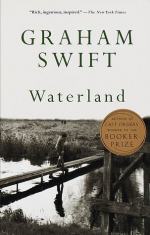
|
| Name: _________________________ | Period: ___________________ |
This test consists of 5 short answer questions, 10 short essay questions, and 1 (of 3) essay topics.
Short Answer Questions
1. Who says, "explaining's a way of avoiding the facts while you pretend to get near to them?"
2. What is the great mystery about the eel that nobody has been able to explain?
3. What does Freddie Parr do to Mary as revenge for setting him up to lose the competition because she knew he couldn't swim?
4. What about the scene at the Lode does NOT remind Tom of the later scene of Freddie Parr's death?
5. What is the worst thing Tom Crick can imagine?
Short Essay Questions
1. In chapter 21, Tom Crick asks, "when the past tries to demolish itself, how do you demolish the past?" What is he getting at?
2. In chapter 20, Price tells Tom Crick that he thinks "explaining's a way of avoiding the facts while you pretend to get near them." Why does Price think he does not need to have explanations for history?
3. In chapter 50, Harry Crick is bed-ridden in Tom's and Mary's first house in Gildsey. What made him ill?
4. In chapter 47, Tom explains why he thinks Mary's mental illness can't be healed. Explain his reasoning.
5. In chapter 33, Tom Crick takes Price to a bar to have a drink. What is the question Price asks Tom that shakes Tom the most?
6. In chapter 37, Tom Crick discusses the idea of terror and how it aids people in pretending they're changing the world for the better. What are some examples Tom gives from the French Revolution?
7. What is the significance of phlegm for the body according to chapter 51?
8. Briefly discuss how, in chapter 44, his interview with the police unravels Tom's earlier ideas about teaching the facts of history.
9. In chapter 23, Tom Crick asserts that the 14th of July festivities the French celebrate as Bastille Day are more of a fairy tale than anything else. What makes him say so?
10. IIn Chapter 43, what significant change occurs in Tom and Price's attitude toward history?
Essay Topics
Write an essay for ONE of the following topics:
Essay Topic 1
Carefully consider the character of Sarah Atkinson from Graham Swift's novel Waterland. Using specific examples from the novel, trace how she captures the imagination of her two sons, of the people of the town of Gildsey, and of her descendants. Finally, analyze what Sarah's life might symbolize in Tom Crick's narrative about the Fens and its people.
Essay Topic 2
Graham Swift's novel Waterland is set in the fictional town on Gildsey and along a fictional river, the River Leem. The Fenlands, the River Ouse, the town of Ely, and many other details are, however, real. In a sense, that fact is symbolic for how the novel treats the relationship between history and story. Using specifics and quotes from the novel, explore the relationship between fact and fiction in the novel. Make sure to include Tom Crick's opinions about history in your discussion.
Essay Topic 3
In Graham Swift's novel Waterland, one major theme is that of being truthful--both towards oneself and towards others. The narrator, Tom, is the best example for that struggle. Give an example from Tom's story (or from his story-telling) of instances when telling the truth matters very much, but either Tom or the reader cannot tell whether the truth is being told. Explore what difference it would have made in that instance if the truth had been told.
|
This section contains 1,122 words (approx. 4 pages at 300 words per page) |

|




